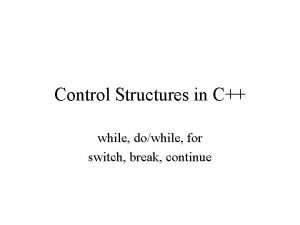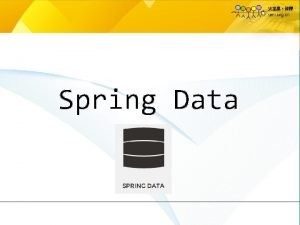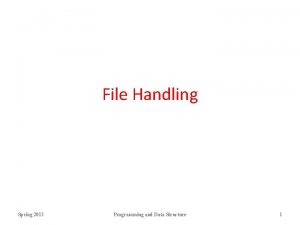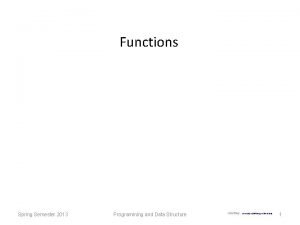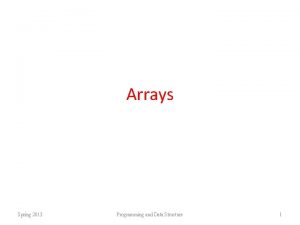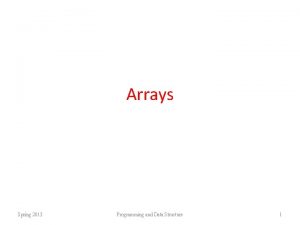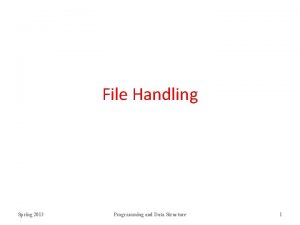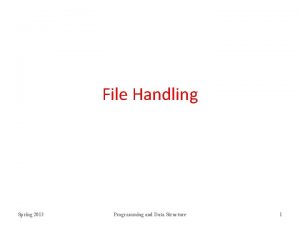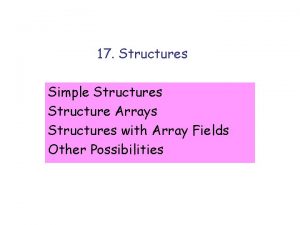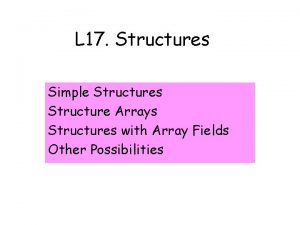Structures Spring 2013 Programming and Data Structure 1




![Example • A structure definition: struct student { }; char name[30]; int roll_number; int Example • A structure definition: struct student { }; char name[30]; int roll_number; int](https://slidetodoc.com/presentation_image_h2/911c54bdc5527666b921e11e7970dd68/image-5.jpg)

![Example struct student { char name[30]; int roll_number; int total_marks; char dob[10]; } a Example struct student { char name[30]; int roll_number; int total_marks; char dob[10]; } a](https://slidetodoc.com/presentation_image_h2/911c54bdc5527666b921e11e7970dd68/image-7.jpg)












- Slides: 19

Structures Spring 2013 Programming and Data Structure 1

What is a Structure? • It is a convenient tool for handling a group of logically related data items. – Student name, roll number, and marks – Real part and complex part of a complex number • This is our first look at a non-trivial data structure. – Helps in organizing complex data in a more meaningful way. • The individual structure elements are called members. Spring 2013 Programming and Data Structure 2

Defining a Structure • The composition of a structure may be defined as: struct tag { member 1; member 2; : member m; }; – struct is the required keyword. – tag is the name of the structure. – member 1, member 2, … are individual member declarations. Spring 2013 Programming and Data Structure 3

Contd. • The individual members can be ordinary variables, pointers, arrays, or other structures. – The member names within a particular structure must be distinct from one another. – A member name can be the same as the name of a variable defined outside of the structure. • Once a structure has been defined, individual structure-type variables can be declared as: struct tag variable_1, variable_2, …, variable_n; Spring 2013 Programming and Data Structure 4
![Example A structure definition struct student char name30 int rollnumber int Example • A structure definition: struct student { }; char name[30]; int roll_number; int](https://slidetodoc.com/presentation_image_h2/911c54bdc5527666b921e11e7970dd68/image-5.jpg)
Example • A structure definition: struct student { }; char name[30]; int roll_number; int total_marks; char dob[10]; • Defining structure variables: struct student a 1, a 2, a 3; } A new data-type Spring 2013 Programming and Data Structure 5

A Compact Form • It is possible to combine the declaration of the structure with that of the structure variables: struct tag { member 1; member 2; : member m; } variable_1, variable_2, …, variable_n; • In this form, “tag” is optional. Spring 2013 Programming and Data Structure 6
![Example struct student char name30 int rollnumber int totalmarks char dob10 a Example struct student { char name[30]; int roll_number; int total_marks; char dob[10]; } a](https://slidetodoc.com/presentation_image_h2/911c54bdc5527666b921e11e7970dd68/image-7.jpg)
Example struct student { char name[30]; int roll_number; int total_marks; char dob[10]; } a 1, a 2, a 3; struct Spring 2013 Equivalent declarations { char name[30]; int roll_number; int total_marks; char dob[10]; } a 1, a 2, a 3; Programming and Data Structure 7

Processing a Structure • The members of a structure are processed individually, as separate entities. • A structure member can be accessed by writing variable. member where variable refers to the name of a structuretype variable, and member refers to the name of a member within the structure. • Examples: – a 1. name, a 2. name, a 1. roll_number, a 3. dob; Spring 2013 Programming and Data Structure 8

Example: Complex number addition #include <stdio. h> main() { struct complex { float real; float complex; } a, b, c; Scope restricted within main() printf (“n %f + %f j”, c. real, c. complex); } Structure definition And Variable Declaration scanf (“%f %f”, &a. real, &a. complex); scanf (“%f %f”, &b. real, &b. complex); c. real = a. real + b. real; c. complex = a. complex + b. complex; Spring 2013 Accessing members Programming and Data Structure Reading a member variable 9

Comparison of Structure Variables • Unlike arrays, group operations can be performed with structure variables. – A structure variable can be directly assigned to another structure variable of the same type. a 1 = a 2; • All the individual members get assigned. – Two structure variables can be compared for equality or inequality. if (a 1 = = a 2) ……. • Compare all members and return 1 if they are equal; 0 otherwise. Spring 2013 Programming and Data Structure 10

Arrays of Structures • Once a structure has been defined, we can declare an array of structures. struct student class[50]; – The individual members can be accessed as: • class[i]. name • class[5]. roll_number Spring 2013 Programming and Data Structure 11

Arrays within Structures • A structure member can be an array: struct student { char name[30]; int roll_number; int marks[5]; char dob[10]; } a 1, a 2, a 3; • The array element within the structure can be accessed as: a 1. marks[2] Spring 2013 Programming and Data Structure 12

Defining data type: using typedef • One may define a structure data-type with a single name. • General syntax: typedef struct { member-variable 1; member-variable 2; . member-variable. N; } tag; • tag is the name of the new data-type. Spring 2013 Programming and Data Structure 13

typedef : An example typedef struct{ float real; float imag; } _COMPLEX; _COMPLEX a, b, c; Spring 2013 Programming and Data Structure 14

Structure Initialization • Structure variables may be initialized following similar rules of an array. The values are provided within the second braces separated by commas. • An example: _COMPLEX a={1. 0, 2. 0}, b={-3. 0, 4. 0}; a. real=1. 0; a. imag=2. 0; b. real=-3. 0; b. imag=4. 0; Spring 2013 Programming and Data Structure 15

Parameter Passing in a Function • Structure variables could be passed as parameters like any other variable. Only the values will be copied during function invokation. void swap(_COMPLEX a, _COMPLEX b) { _COMPLEX tmp; tmp=a; a=b; b=tmp; } Spring 2013 Programming and Data Structure 16

An example program #include <stdio. h> typedef struct{ float real; float imag; } _COMPLEX; void swap(_COMPLEX a, _COMPLEX b) { _COMPLEX tmp; tmp=a; a=b; b=tmp; } Spring 2013 Programming and Data Structure 17

Example program: contd. void print(_COMPLEX a) { printf("(%f , %f) n", a. real, a. imag); } main() { _COMPLEX x={4. 0, 5. 0}, y={10. 0, 15. 0}; print(x); print(y); swap(x, y); print(x); print(y); } Spring 2013 Programming and Data Structure 18

Returning structures • It is also possible to return structure values from a function. The return data type of the function should be as same as the data type of the structure itself. COMPLEX add (COMPLEX a, COMPLEX b) { COMPLEX tmp; Direct arithmetic operations are not tmp. real = a. real+b. real; possible with tmp. imag = a. imag+b. imag; Structure variables. return(tmp); } Spring 2013 Programming and Data Structure 19
 Four seasons korean movie
Four seasons korean movie Spring summer fall winter
Spring summer fall winter Static data structures
Static data structures Analogous structures
Analogous structures Control structures in c
Control structures in c Perbedaan linear programming dan integer programming
Perbedaan linear programming dan integer programming Greedy algorithm vs dynamic programming
Greedy algorithm vs dynamic programming What is system program
What is system program Linear vs integer programming
Linear vs integer programming Definisi linear
Definisi linear Professor ajit diwan
Professor ajit diwan Cos 423 princeton
Cos 423 princeton Data structures and algorithms tutorial
Data structures and algorithms tutorial What is conditional macro expansion
What is conditional macro expansion Assembler data structures
Assembler data structures Information retrieval data structures and algorithms
Information retrieval data structures and algorithms Data structures and abstractions with java
Data structures and abstractions with java Data structures and algorithms bits pilani
Data structures and algorithms bits pilani Adts, data structures, and problem solving with c++
Adts, data structures, and problem solving with c++ Ajit diwan iitb
Ajit diwan iitb




